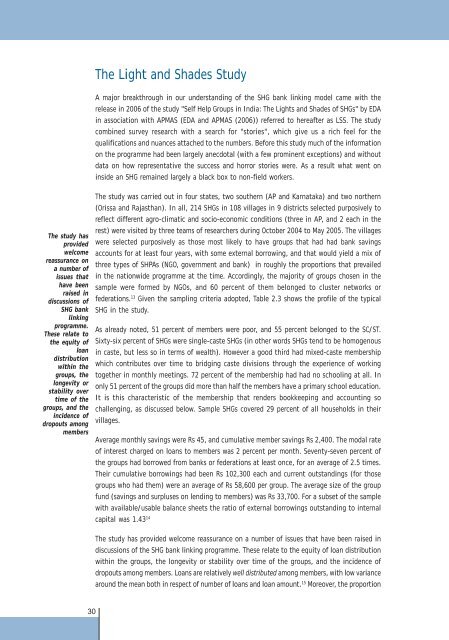Download sector_report1.pdf - Microfinance and Development ...
Download sector_report1.pdf - Microfinance and Development ...
Download sector_report1.pdf - Microfinance and Development ...
You also want an ePaper? Increase the reach of your titles
YUMPU automatically turns print PDFs into web optimized ePapers that Google loves.
The Light <strong>and</strong> Shades Study<br />
A major breakthrough in our underst<strong>and</strong>ing of the SHG bank linking model came with the<br />
release in 2006 of the study "Self Help Groups in India: The Lights <strong>and</strong> Shades of SHGs" by EDA<br />
in association with APMAS (EDA <strong>and</strong> APMAS (2006)) referred to hereafter as LSS. The study<br />
combined survey research with a search for "stories", which give us a rich feel for the<br />
qualifications <strong>and</strong> nuances attached to the numbers. Before this study much of the information<br />
on the programme had been largely anecdotal (with a few prominent exceptions) <strong>and</strong> without<br />
data on how representative the success <strong>and</strong> horror stories were. As a result what went on<br />
inside an SHG remained largely a black box to non-field workers.<br />
The study has<br />
provided<br />
welcome<br />
reassurance on<br />
a number of<br />
issues that<br />
have been<br />
raised in<br />
discussions of<br />
SHG bank<br />
linking<br />
programme.<br />
These relate to<br />
the equity of<br />
loan<br />
distribution<br />
within the<br />
groups, the<br />
longevity or<br />
stability over<br />
time of the<br />
groups, <strong>and</strong> the<br />
incidence of<br />
dropouts among<br />
members<br />
The study was carried out in four states, two southern (AP <strong>and</strong> Karnataka) <strong>and</strong> two northern<br />
(Orissa <strong>and</strong> Rajasthan). In all, 214 SHGs in 108 villages in 9 districts selected purposively to<br />
reflect different agro-climatic <strong>and</strong> socio-economic conditions (three in AP, <strong>and</strong> 2 each in the<br />
rest) were visited by three teams of researchers during October 2004 to May 2005. The villages<br />
were selected purposively as those most likely to have groups that had had bank savings<br />
accounts for at least four years, with some external borrowing, <strong>and</strong> that would yield a mix of<br />
three types of SHPAs (NGO, government <strong>and</strong> bank) in roughly the proportions that prevailed<br />
in the nationwide programme at the time. Accordingly, the majority of groups chosen in the<br />
sample were formed by NGOs, <strong>and</strong> 60 percent of them belonged to cluster networks or<br />
federations. 13 Given the sampling criteria adopted, Table 2.3 shows the profile of the typical<br />
SHG in the study.<br />
As already noted, 51 percent of members were poor, <strong>and</strong> 55 percent belonged to the SC/ST.<br />
Sixty-six percent of SHGs were single-caste SHGs (in other words SHGs tend to be homogenous<br />
in caste, but less so in terms of wealth). However a good third had mixed-caste membership<br />
which contributes over time to bridging caste divisions through the experience of working<br />
together in monthly meetings. 72 percent of the membership had had no schooling at all. In<br />
only 51 percent of the groups did more than half the members have a primary school education.<br />
It is this characteristic of the membership that renders bookkeeping <strong>and</strong> accounting so<br />
challenging, as discussed below. Sample SHGs covered 29 percent of all households in their<br />
villages.<br />
Average monthly savings were Rs 45, <strong>and</strong> cumulative member savings Rs 2,400. The modal rate<br />
of interest charged on loans to members was 2 percent per month. Seventy-seven percent of<br />
the groups had borrowed from banks or federations at least once, for an average of 2.5 times.<br />
Their cumulative borrowings had been Rs 102,300 each <strong>and</strong> current outst<strong>and</strong>ings (for those<br />
groups who had them) were an average of Rs 58,600 per group. The average size of the group<br />
fund (savings <strong>and</strong> surpluses on lending to members) was Rs 33,700. For a subset of the sample<br />
with available/usable balance sheets the ratio of external borrowings outst<strong>and</strong>ing to internal<br />
capital was 1.43 14<br />
The study has provided welcome reassurance on a number of issues that have been raised in<br />
discussions of the SHG bank linking programme. These relate to the equity of loan distribution<br />
within the groups, the longevity or stability over time of the groups, <strong>and</strong> the incidence of<br />
dropouts among members. Loans are relatively well distributed among members, with low variance<br />
around the mean both in respect of number of loans <strong>and</strong> loan amount. 15 Moreover, the proportion<br />
30














